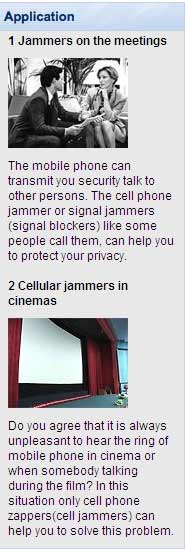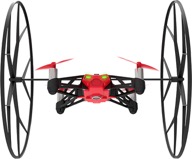Drones & Spectrum:•Will FCC Policy Vacuum Trigger Jamming Increase?
•Will Propagation from Altitude Overload Already Crowded Spectrum?
•Will Propagation from Altitude Overload Already Crowded Spectrum?
Seattle Woman Spooked by Drone Outside Her Window
The GPS and cellular industry are vehemently against jamming of their spectrum and are pressing FCC for more rigorous action. The recent June 20 FCC workshop on “GPS Protection and Receiver Performance” was full of pledges to step up enforcement and the recent $34,912,500 NAL to a Chinese jammer manufacturer was an attempt by FCC to show its commitment to such enforcement - although the likelihood of the perpetrator ever paying anything is slight.
From an actual jammer ad

The picture at left comes from a cellular jammer ad and shows the pitch they are using. (We will not give the original source here but it has been shared with FCC/EB.)
While FAA is working under a congressional mandate to resolve its regulations for drones, FCC seems disinterested in the matter -- except in the context of the NPSTC National 4.9 GHz Plan for public safety users. But as the NY Times reported yesterday “Drones Outpacing Rules as Popularity Soars in New York”.
Using either cellular spectrum or unlicensed spectrum from drones is really a bad idea and should be forbidden.
Why? There are good technical reasons why we have frequency allocations for the Aeronautical Mobile Service where drone-related communication should be. The range of a radio signal (and its potential interference to other users) is determined both by its transmitter’s height as well as its (effective radiated) power. Airplanes and drones are at much higher heights than terrestrial users.
The unlicensed and cellular bands and their technical rules were designed for terrestrial use. Using cellular or unlicensed spectrum at even several hundred foot altitude will impact other users much more than comparable terrestrial use. For example, in a dense cellular repeater environment, a drone-based cellphone will likely hit several repeaters with comparable power and use up disproportionate spectrum capacity. Similarly, it will disproportionately increase the apparent load in unlicensed systems, effectively decreasing their capacity much more than a terrestrial user with the same bit rate.
In addition to this overload problem, drone based imagery will likely be seen by many as invasive as shown in the video at the top of this post. Experience has shown that such feelings often lead to interest in jamming for self-protection. While such jamming is illegal, it is growing and FCC actions to date under present laws and rules have had little impact. Thus it is likely that the growth of drone-based imagery in the unlicensed bands and cellular bands will be accompanied by a surge of jamming to the detriment of all cellular and unlicensed users!
So why isn’t anything being done? Look back a few blog entries to the “VA and FCC” entry here. Your blogger believes that like the VA, FCC is operating at a throughput less than that required for its actual spectrum policy role. In this hypothesis, major regulatees, both licensed and unlicensed, are implicitly or explicitly told to limit their requests to FCC so they can at least get their key requests accomplished.
What could be done about drones at FCC to prevent drone based downlinks from adversely impacting unlicensed systems and cellular systems? The previous drone post here advocated amending § 15.9 to forbid drone based imagery as well as the currently forbidden (for non law enforcement) “eavesdropping”. With respect to cellular systems, both § 22.925 and § 91.21 limit use of transmitters in "1) Aircraft operated by a holder of an air carrier operating certificate or an operating certificate; or (2) Any other aircraft while it is operated under IFR" and "aboard airplanes, balloons or any other type of aircraft". We urge FCC to amend these to forbid use of cellular spectrum from drones and urge the cellular community to tell FCC this is an urgent matter.
Note that we are not advocating that FCC forbid spectrum for drones, rather that such spectrum use be in bands that are planned for such use considering the heights involved in it.
Sprint’s New Drone

Review of a Consumer Drone Using 2.4 and 5 GHz Unlicensed Spectrum
blog comments powered by Disqus



![Validate my RSS feed [Valid RSS]](valid-rss-rogers.png)

